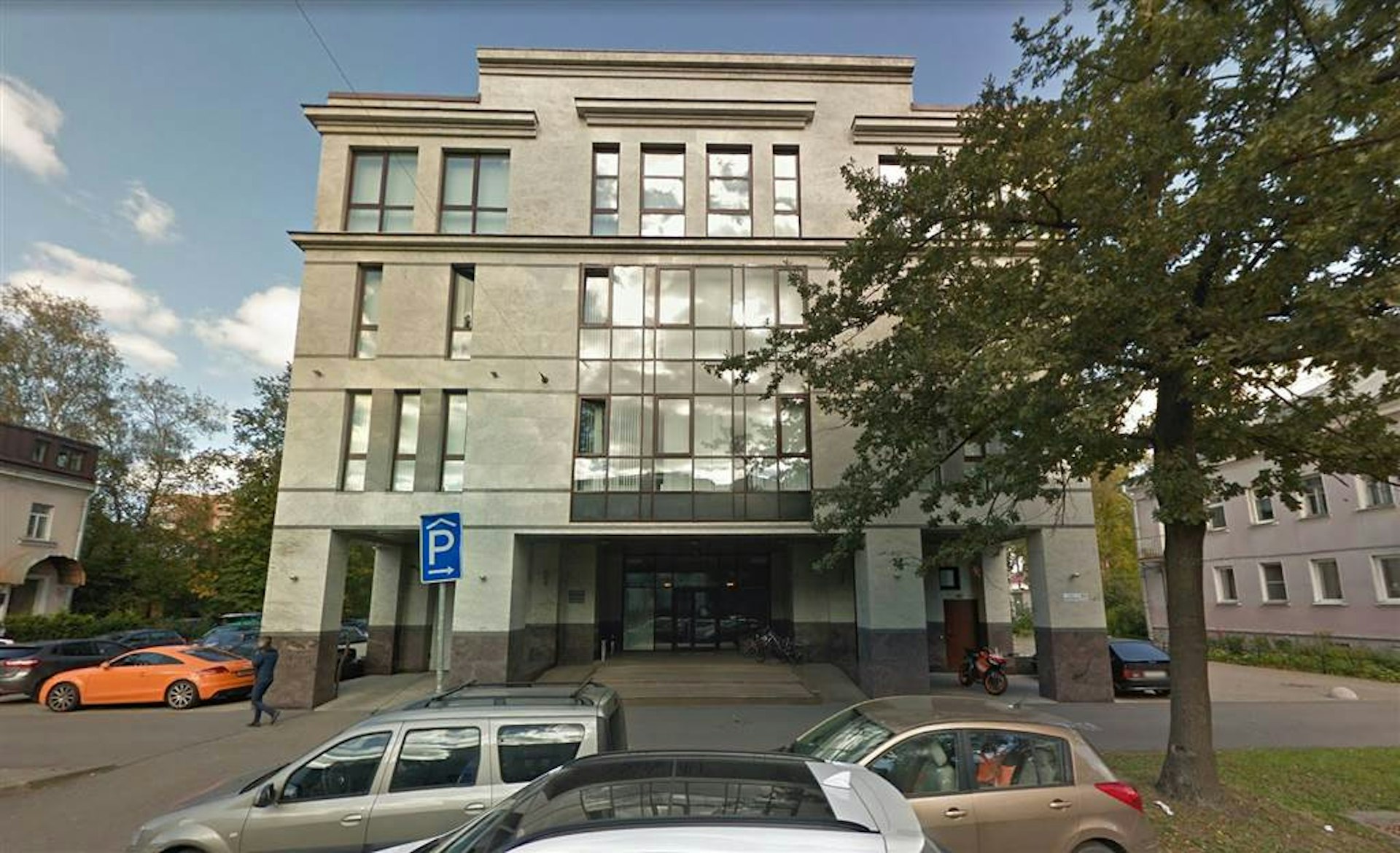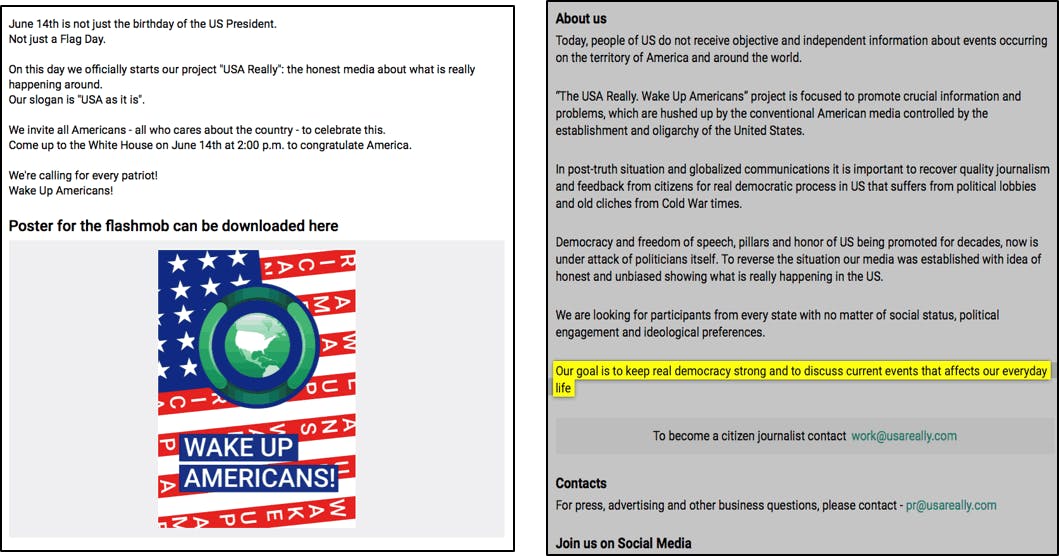Click here to download the report »
New tests show Google has done little to stop foreign actors from improperly influencing US elections
- Campaign for Accountability was able to run ads created by Russian trolls on Google’s platforms, targeting U.S. audiences
- The Russian AdWords account was set up using the name and identifying details of the Kremlin-linked troll farm
- The ads were paid for in Russian rubles and ran on major U.S. media properties
For months, Google has trumpeted a set of strict new rules put in place to stop rogue foreign actors from abusing its platform to influence U.S. elections. No longer, it said, would foreign adversaries be able to buy political ads or spread divisive propaganda, as Russian operatives did freely during the 2016 campaign.
But a series of tests shows Google has done little to strengthen its defenses. Just five months before the 2018 midterm elections, CfA was able to buy ads on Google’s Russian ad platform targeting U.S. internet users. It used the name and identifying details of the Kremlin-linked troll farm that led Russia’s campaign to influence the last presidential election. It even paid for the ads in Russian rubles.
Google then ran the ads on a wide range of web sites and YouTube channels, including CNN, CBS This Morning, The Daily Beast, Huffington Post, AnnCoulter.com and Britain’s Daily Mail.
The troll farm, formally known as the Internet Research Agency (IRA), has been the subject of innumerable articles since the 2016 election and was indicted by the special counsel investigating U.S. election interference. Notwithstanding its notoriety, CfA was able to easily set up a Russian AdWords account, using the name, street address and tax identification number of the St. Petersburg-based troll farm. Google even helpfully prepopulated the troll farm’s contact details.
Google quickly approved the ads, which used similar language and many of the same images that were created by the troll farm in 2016. Many of the images approved by Google had already been identified by U.S. congressional investigators or widely revealed in the U.S. media to be Russian propaganda efforts.
Google also approved display ads directing U.S. internet users to sites identified by congressional investigators and the media as having been created and run by the Russian trolls.
The ease with which CfA was able to replicate the Russian campaign of 2016 undermines Google’s claims to have fortified its platform against outside manipulation. Amid revelations that Russian operatives spent tens of thousands of dollars buying Google ads to influence the 2016 U.S. election, Google said in October 2017 that it employed “a set of strict ad policies including limits on political ad targeting.”
Ten months later, in August 2018, Google touted its investment in “robust systems” to “identify influence operations launched by foreign governments” on its platforms.
None of these steps deterred CfA’s testers. CfA was able to replicate a small-scale influence campaign with less than $100, using only a burner phone to register the Google account and a Yandex account to transfer funds to Google AdWords.
In an effort to trigger Google’s safeguards, the test waved obvious red flags throughout. CfA posed as Russians while buying political ads targeted at U.S. users. We used a Russian IP address, accessed Google’s Russian AdWords platform and supplied the details of the indicted Russian troll farm. CfA submitted ad copy and promoted websites created by the troll farm. And CfA paid for them in Russian currency using Yandex, Russia’s largest online payment service.
Google’s failure to block our test ads also stands in contrast to Facebook’s announcement in July 2018 that it had detected and removed 32 pages and fake accounts after identifying a possible campaign to disrupt the U.S. midterm elections. In August 2018, Facebook announced it had uncovered another set of Russian and Iranian account networks aimed at influencing Americans and citizens of other nations.
The ads associated with those Facebook accounts appear to have been considerably more difficult to detect than those that plagued the 2016 election. The accounts used virtual private networks to mask their true location, they relied on third parties to buy the ads, and the ads were paid for with U.S. and Canadian dollars. Facebook does not allow payment using prepaid credit cards or Yandex and requires a valid bank, PayPal or credit card account to purchase ads, making a similar experiment more difficult.
By contrast, CfA made no attempt to give our ads even the appearance of legitimacy when submitting them to Google. CfA created phony ads and then directed them at known Russian troll websites including BlackMattersUS.com and USAReally.com.
The former site was used by the IRA during the 2016 election to stoke racial tensions and stir political unrest by co-opting American civil rights activists. USAReally.com entered the scene more recently. In June 2018, internet researchers identified the site as the latest in Russia’s attempt to undermine U.S. democracy by publishing wild conspiracy theories as news and attempting to organize political rallies to support President Donald Trump.
Google made no attempts to verify the identity of the Russian account and approved the ads in as little as 24 hours. In one case, Google even recommended images directly from one of the Russian troll sites as we were preparing our AdWords campaign.
The campaigns were surprisingly cheap. Our ads received over 20,000 views and more than 200 clicks, all for a total advertising cost of around $35.
Google’s far-reaching platforms were central to Russia’s effort to disrupt the election, giving its operatives far greater contact with American voters than they could obtain through social media platforms like Facebook and Twitter alone. Through its search and email ads, and ads on millions of third-party websites run through Google AdSense and DoubleClick, Google operates the world’s biggest online advertising business.
The company also owns YouTube, the world's largest online video site, which hosted propaganda videos and ads bought by Russia in the run-up to the 2016 election.
Posing as Trolls: Here’s how CfA Bought IRA Ads
Step One: Purchase Burner Phone and Prepaid Mobile Phone Chips
The email and AdWords providers we used to register our accounts required a cell phone number. To make it hard to trace and see if we activated any safeguards, we asked a travelling friend to purchase a cheap Nokia burner phone for $15.99 from a small market in Panama and $5 mobile chips from three different Panama mobile providers. We then activated each phone chip with a $5 scratch-off phone card.
Cost: Burner phone and prepaid credit card: $45.99

Burner phone and mobile chips purchased here
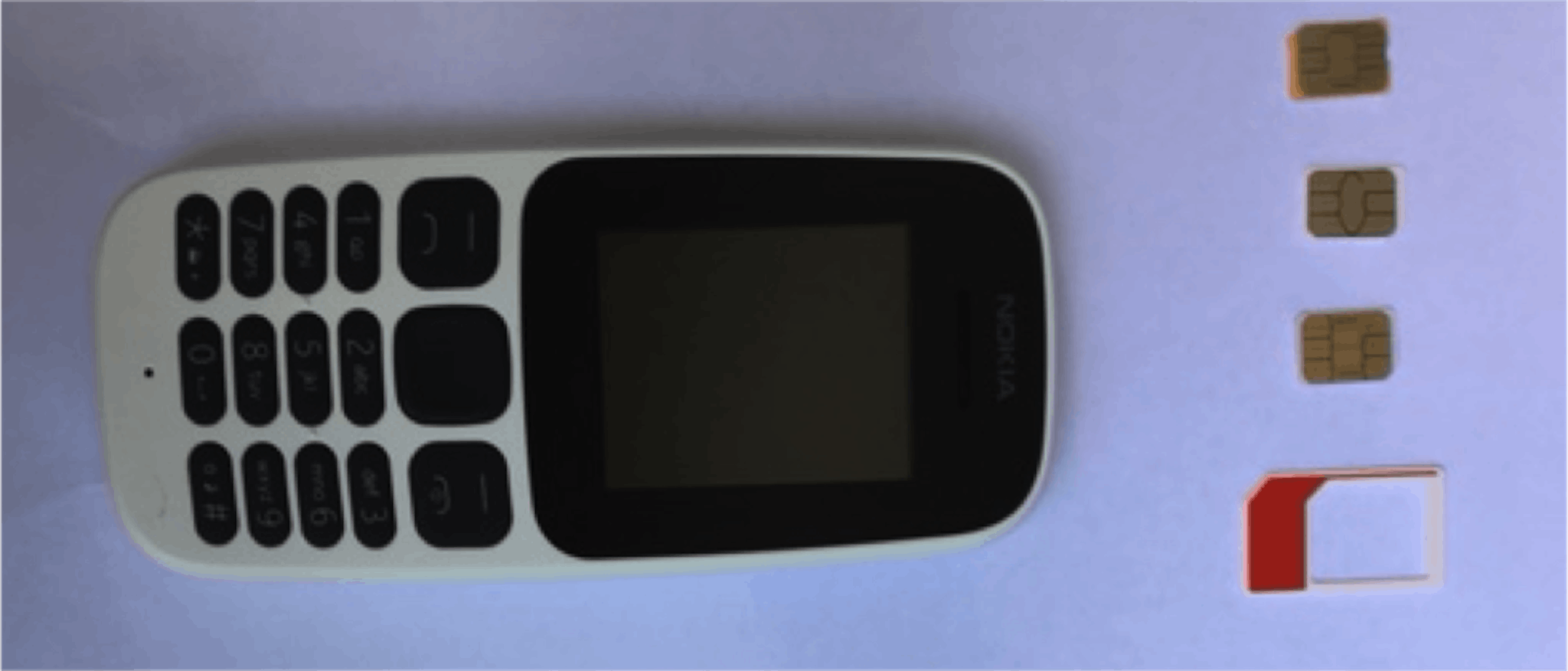
Cheap Nokia phone and mobile chips
Step Two: Set up Russian email account through Yandex.com
We then set up a free email account using Yandex.com, Russia’s largest internet and email provider. Yandex primarily serves users in Russia and Russian Commonwealth states. Its founders and most of the company’s employees are located in Russia. Yandex also provides the designated mail server for Russian troll site USAReally.com.

Create a free email account at https://mail.yandex.com/
Our first step was to choose a common Russian name for our Yandex email account. This would be the same name we used to register our Russian AdWords account as well. A Google search of common Russian names provided the answer: “Mikhail Sokolov.”
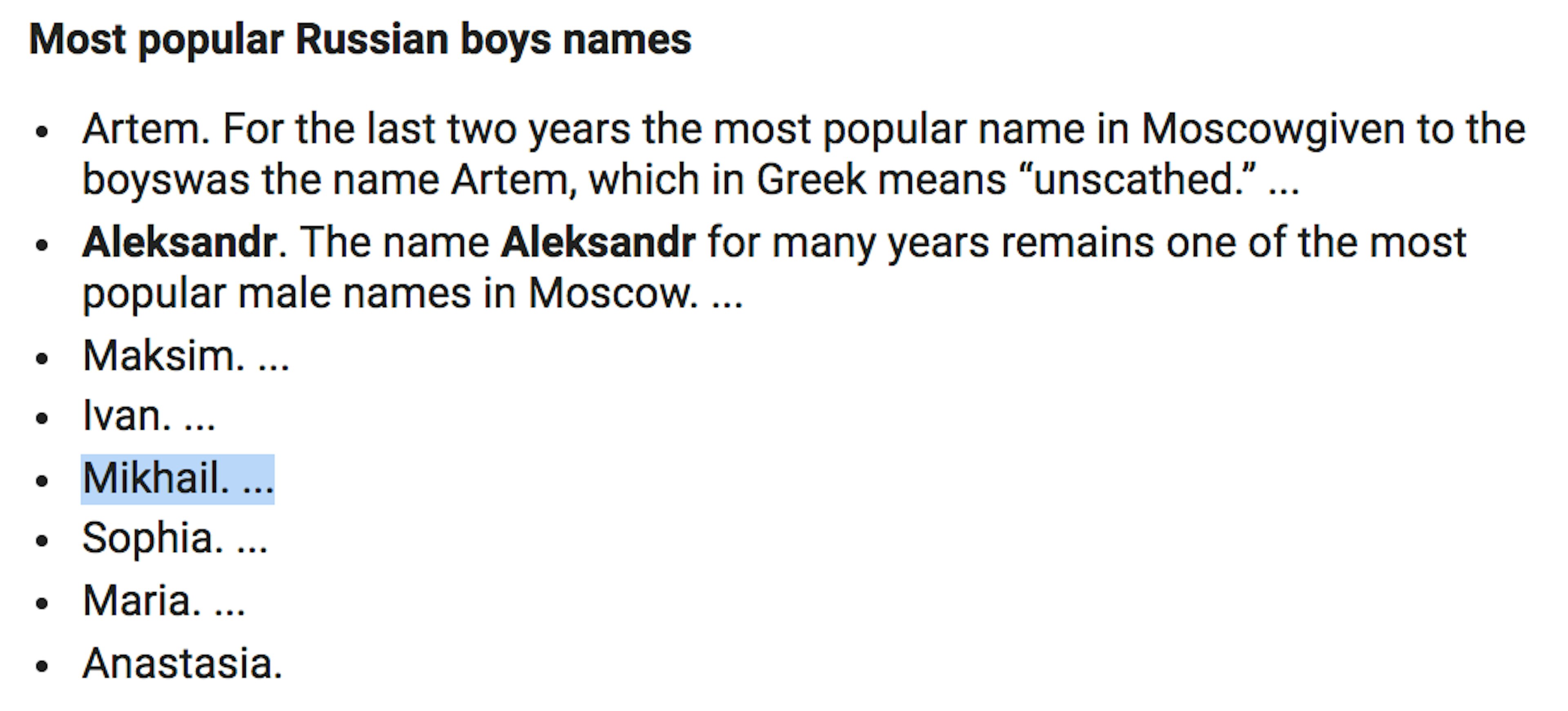
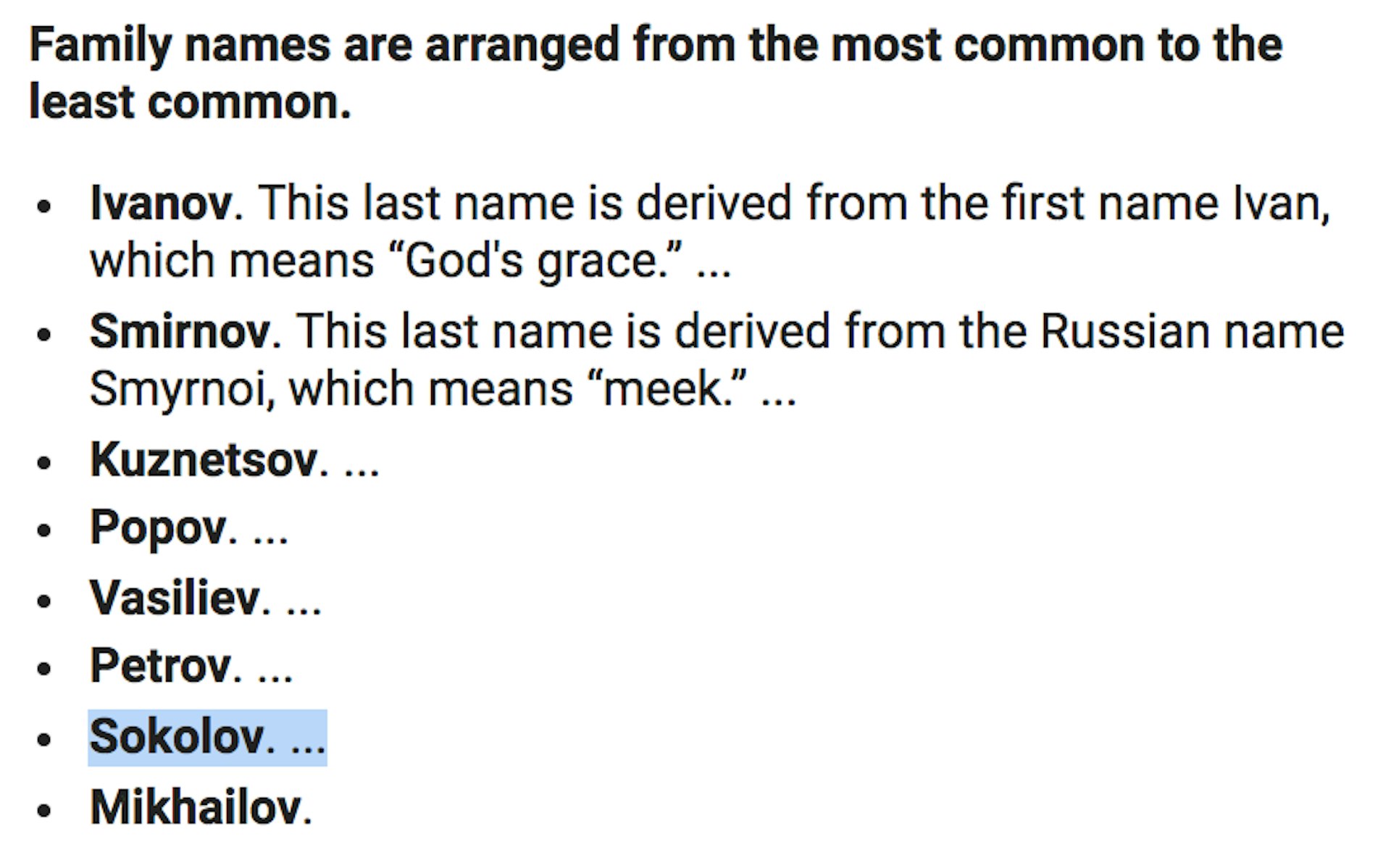
Next, we created our Yandex email login name and password and entered our Panama burner phone number to receive the confirmation code to create the account.
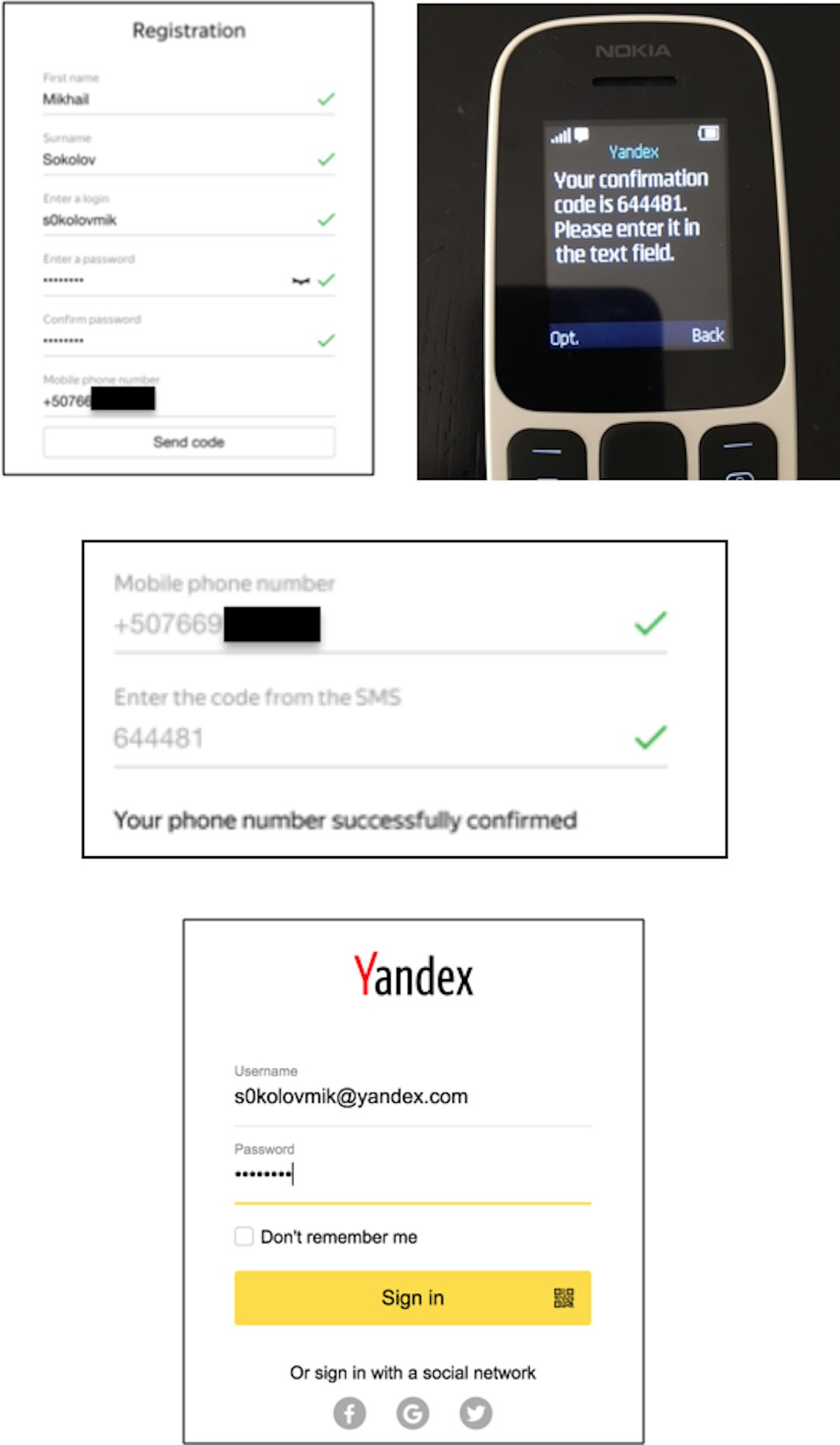
Cost: Free
With our official Yandex email account, we were now ready to register our Russian Google AdWords account.
Step Three: Download NordVPN
Before creating our Russian AdWords account, we wanted to ensure that any IP addresses logged by Google were Russian, so we downloaded NordVPN’s virtual private network software and subscribed to the service for $11.99 per month. We then used the service to log in to a Russian server.
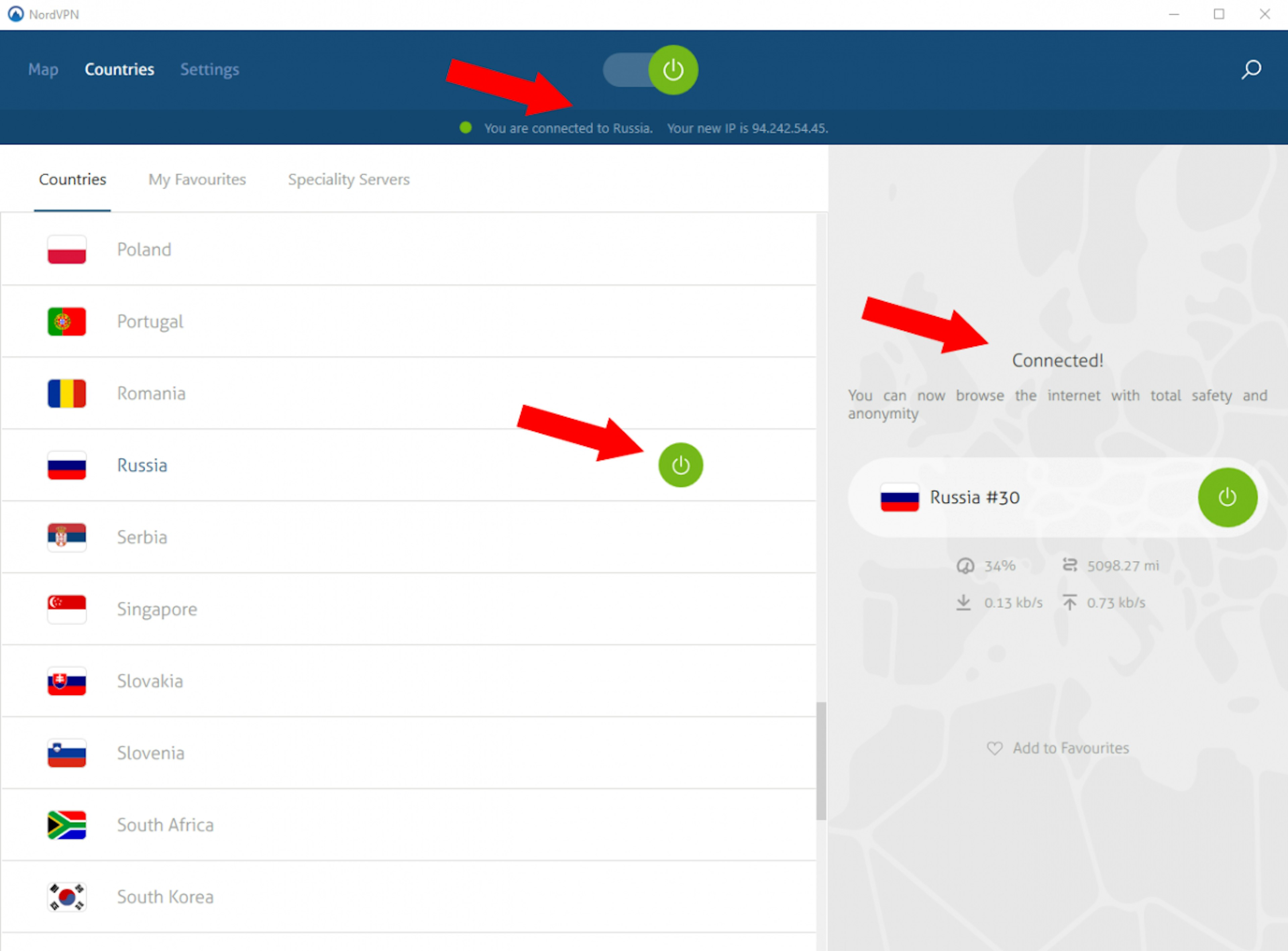
NordVPN’s laptop software offering VPN option in Russia
We confirmed that we were logged into a Russian server by checking our IP address at www.whatismyipaddress.com. Our Russian IP address was in St. Petersburg, the same city in which the Internet Research Agency is located.
Cost: $11.99 per month

Step Four: Register new Russian AdWords account
Before creating our account, we logged into NordVPN through a Russian server and navigated to the Google Russia AdWords page. (In late July, Google AdWords was rebranded, becoming Google Ads.)

We automatically translated the Russian Google AdWords page to English by clicking the Google translate icon in the upper right-hand side of the Chrome browser.
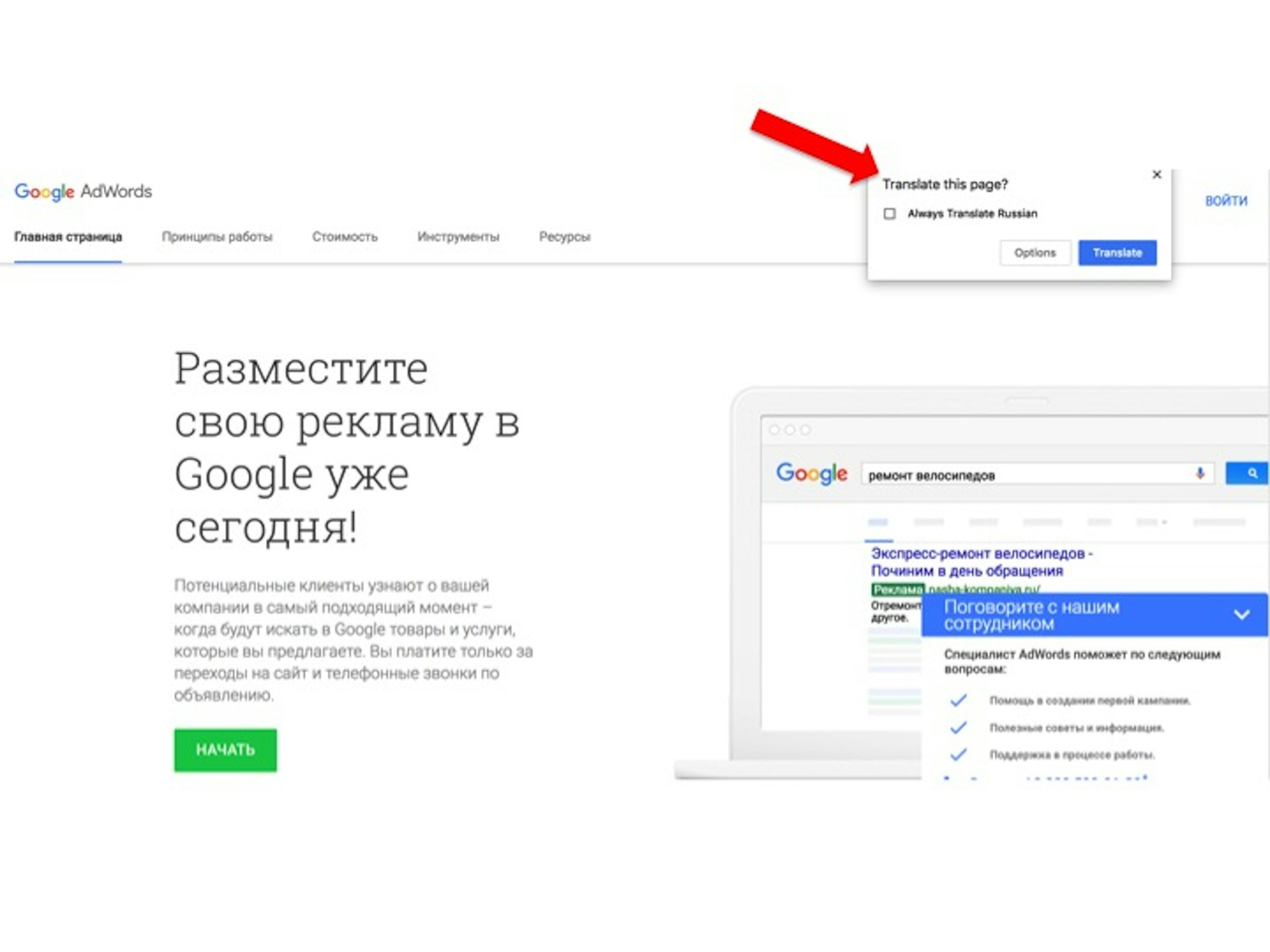
Google’s Russian AdWords page
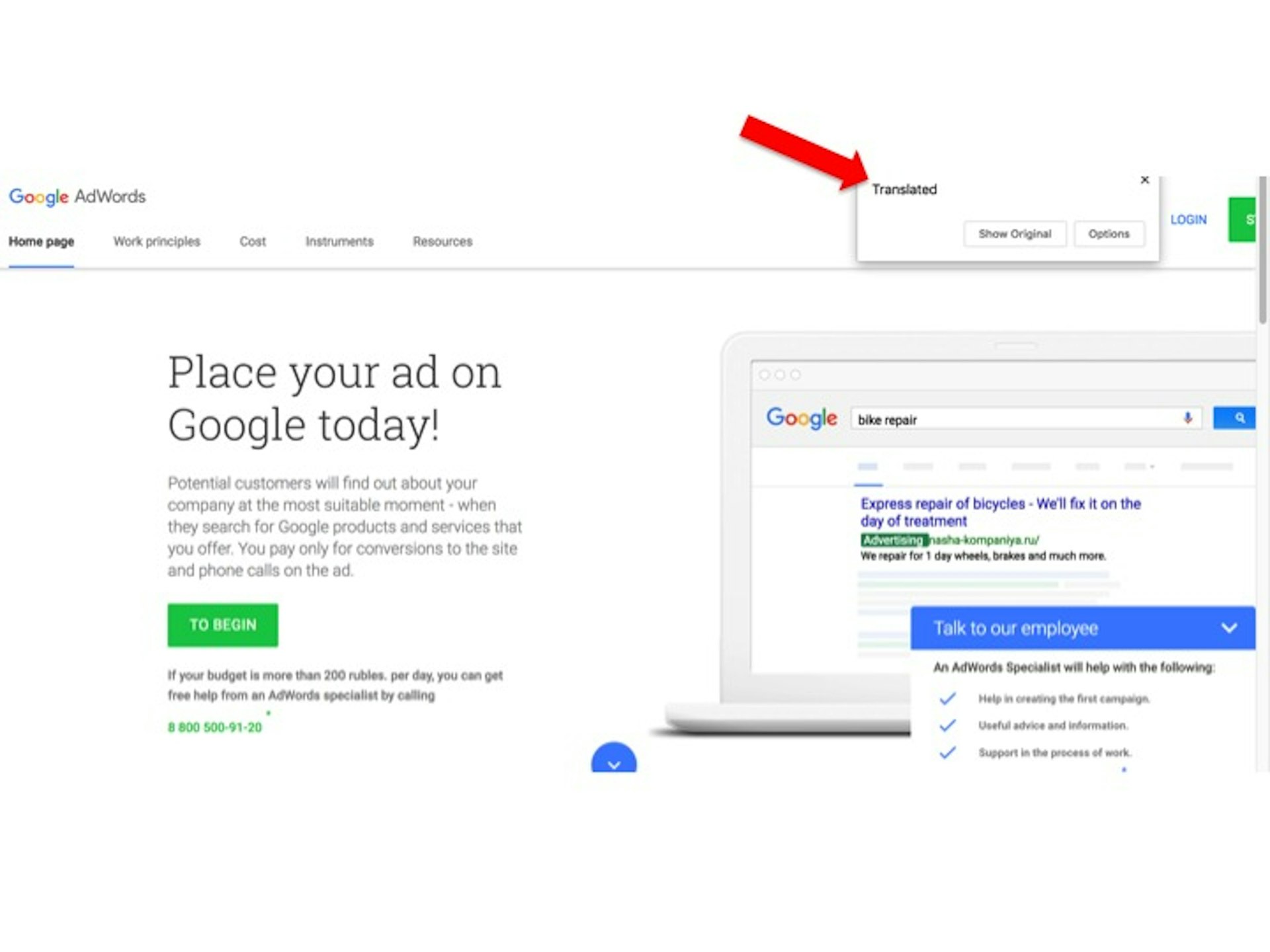
Translated into English through Chrome browser
We then created our AdWords account using the Yandex email address created in Step Two and our Panama burner phone.
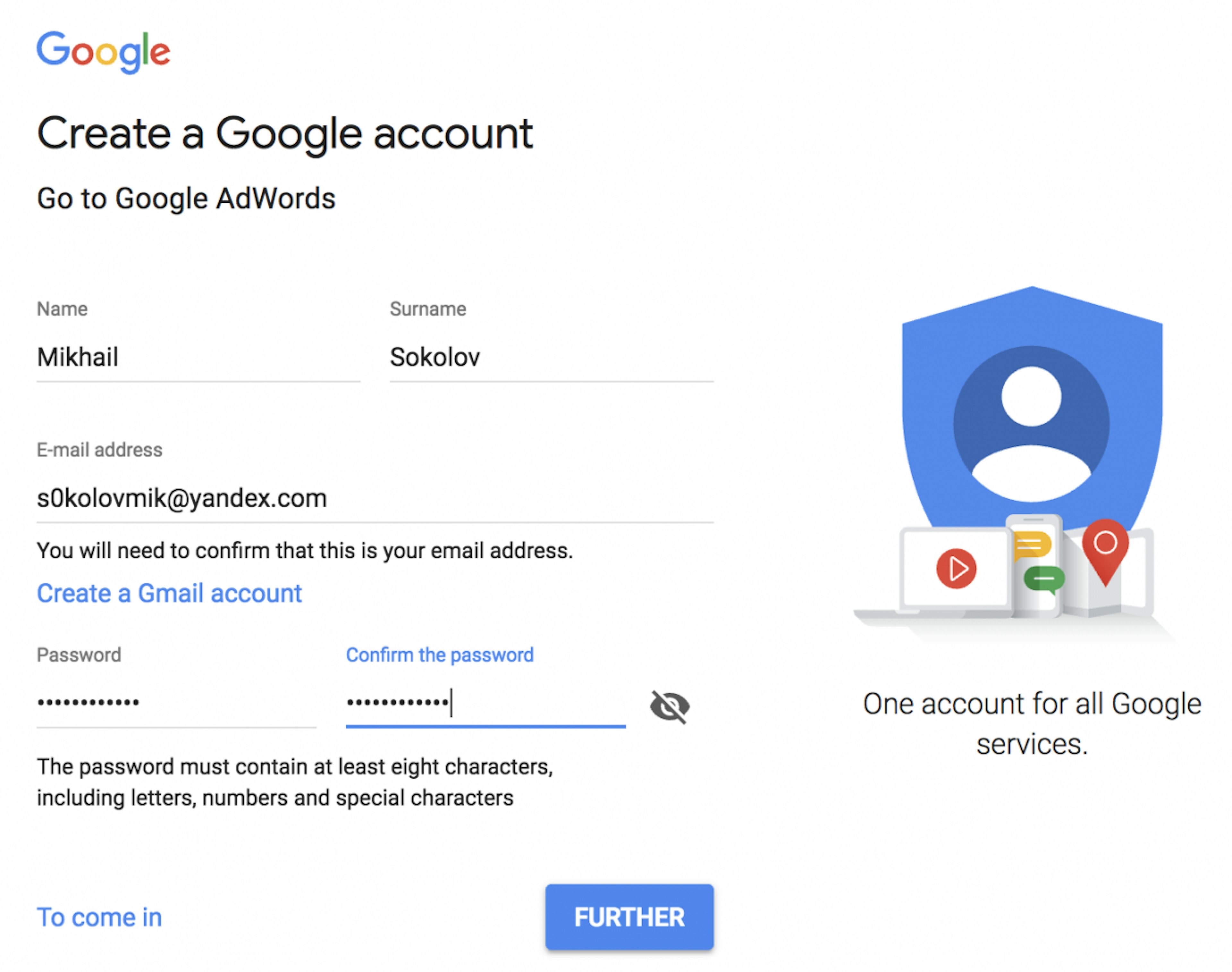
Following prompts from Google AdWords, we verified our Yandex email address.
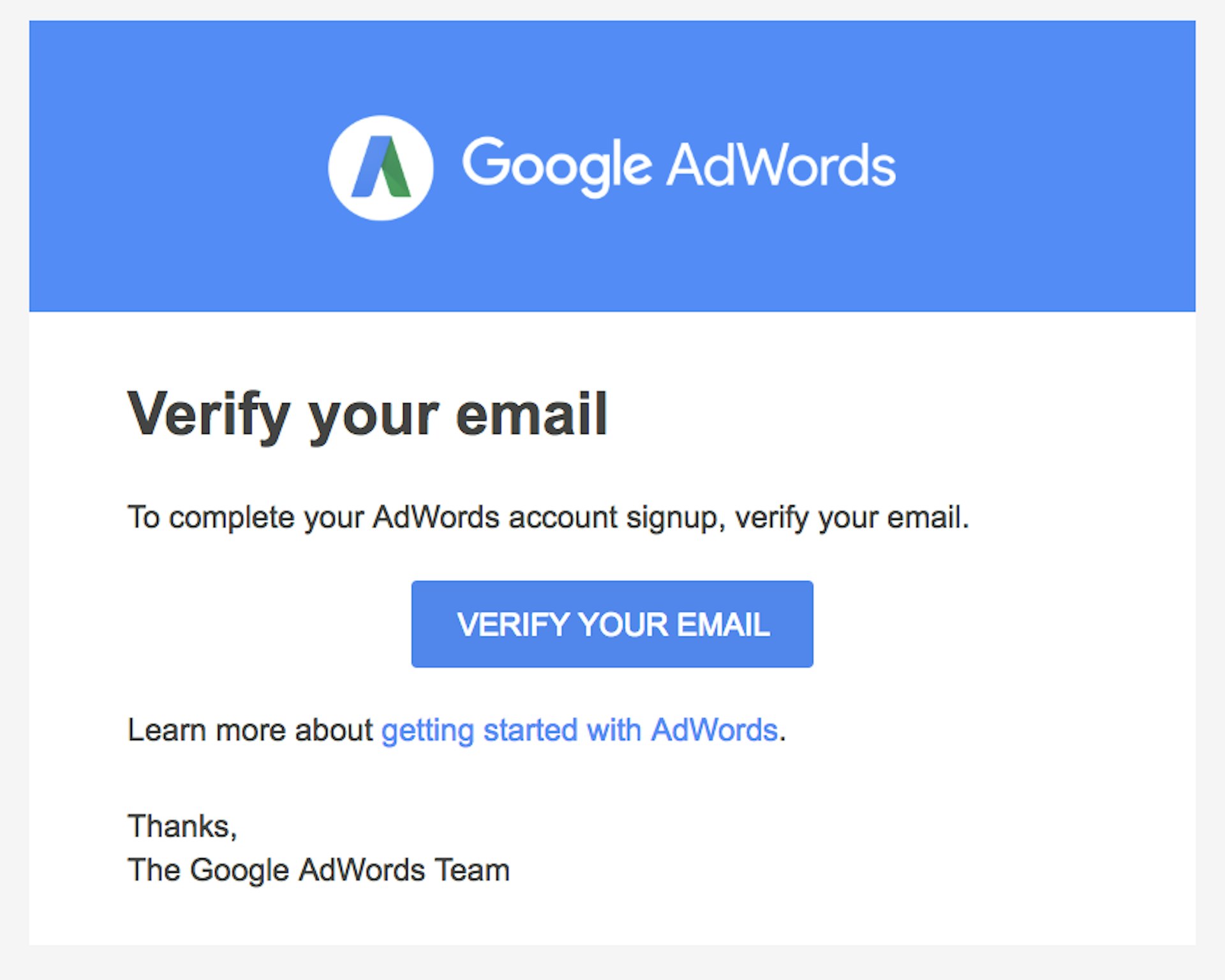
We then confirmed our phone number using the code sent to our Nokia burner phone.
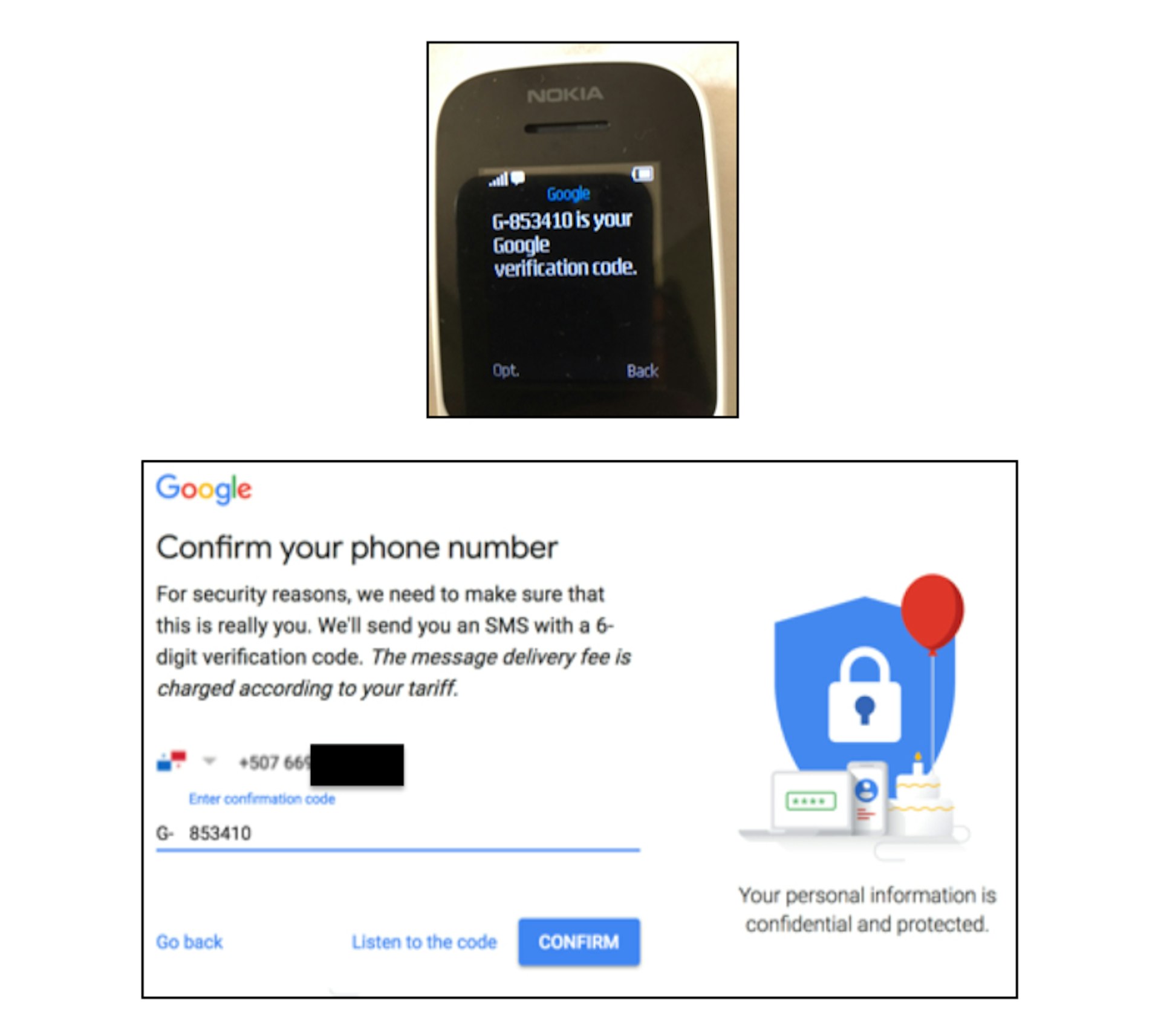
With those simple steps, we created our official Russian AdWords account
Cost: Free

Step Five: Set up billing for our AdWords account
Once we had our AdWords account set up, we entered billing information for the Russian Internet Research Agency, details that might be expected to draw scrutiny given the troll farm’s well-documented history.
For our test, we entered the Russian taxpayer numbers for the IRA. Data on Russian companies, including tax IDs, is freely available on the web. A Google search for the Internet Research Agency found dozens of sites with its tax ID and other company registration details.
After entering the numbers, Google helpfully populated the “Business name and address” fields of our account automatically, filling in its name and St. Petersburg address.

We then set up our payment method through Yandex, Russia’s largest electronic payment service, and transferred 2,500 rubles (roughly $40 at the time) into the AdWords account.
Cost: $40.00
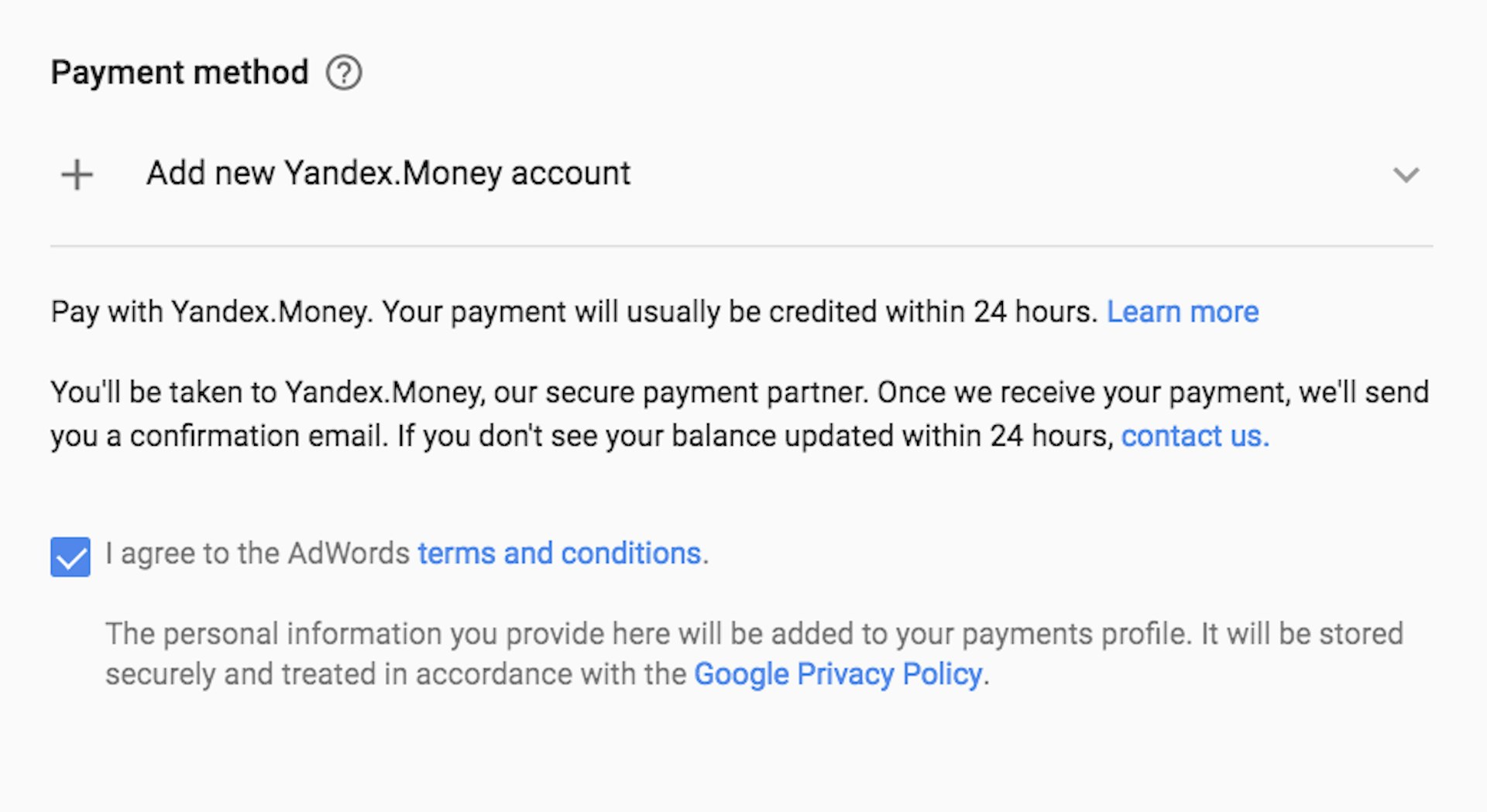
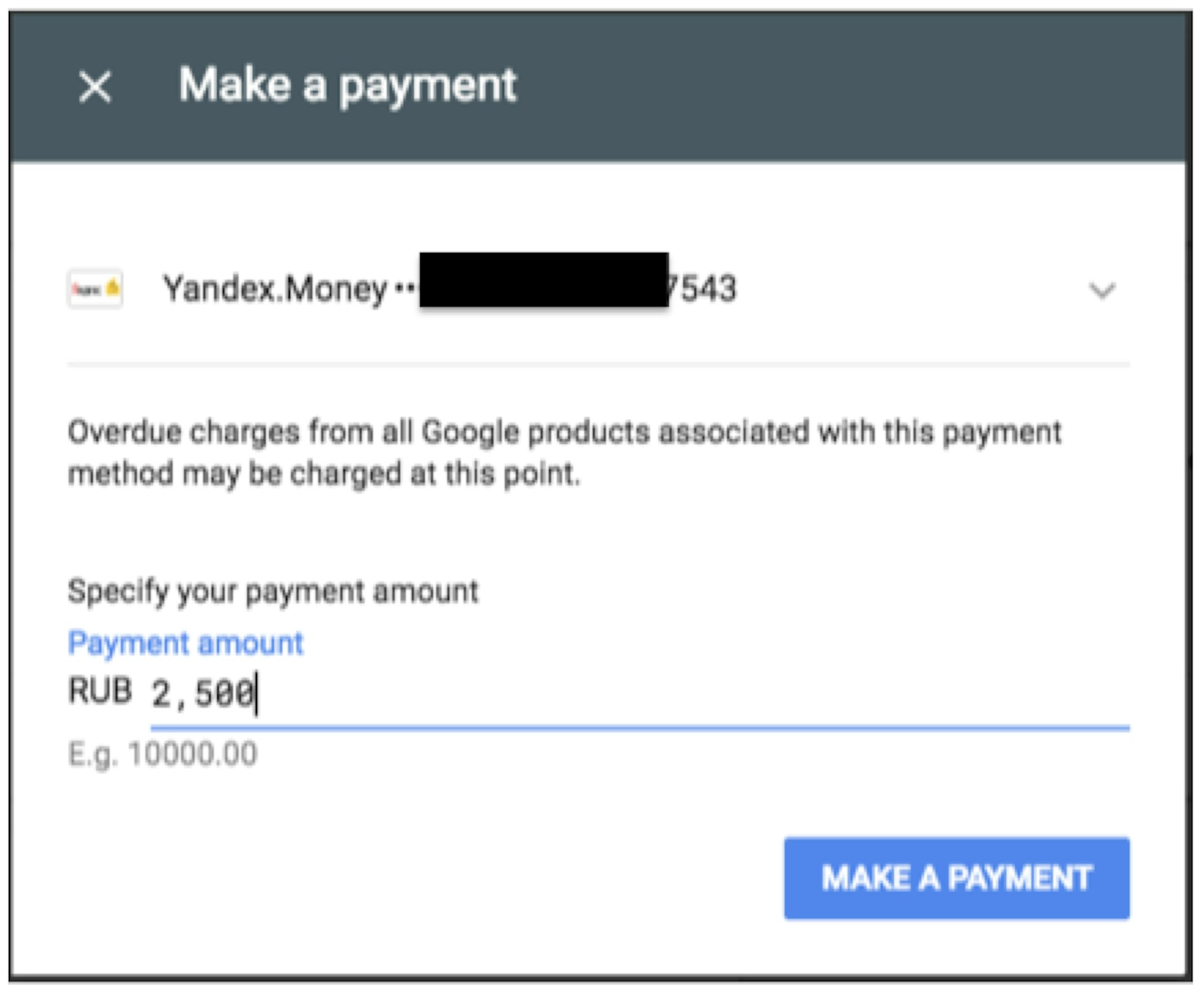
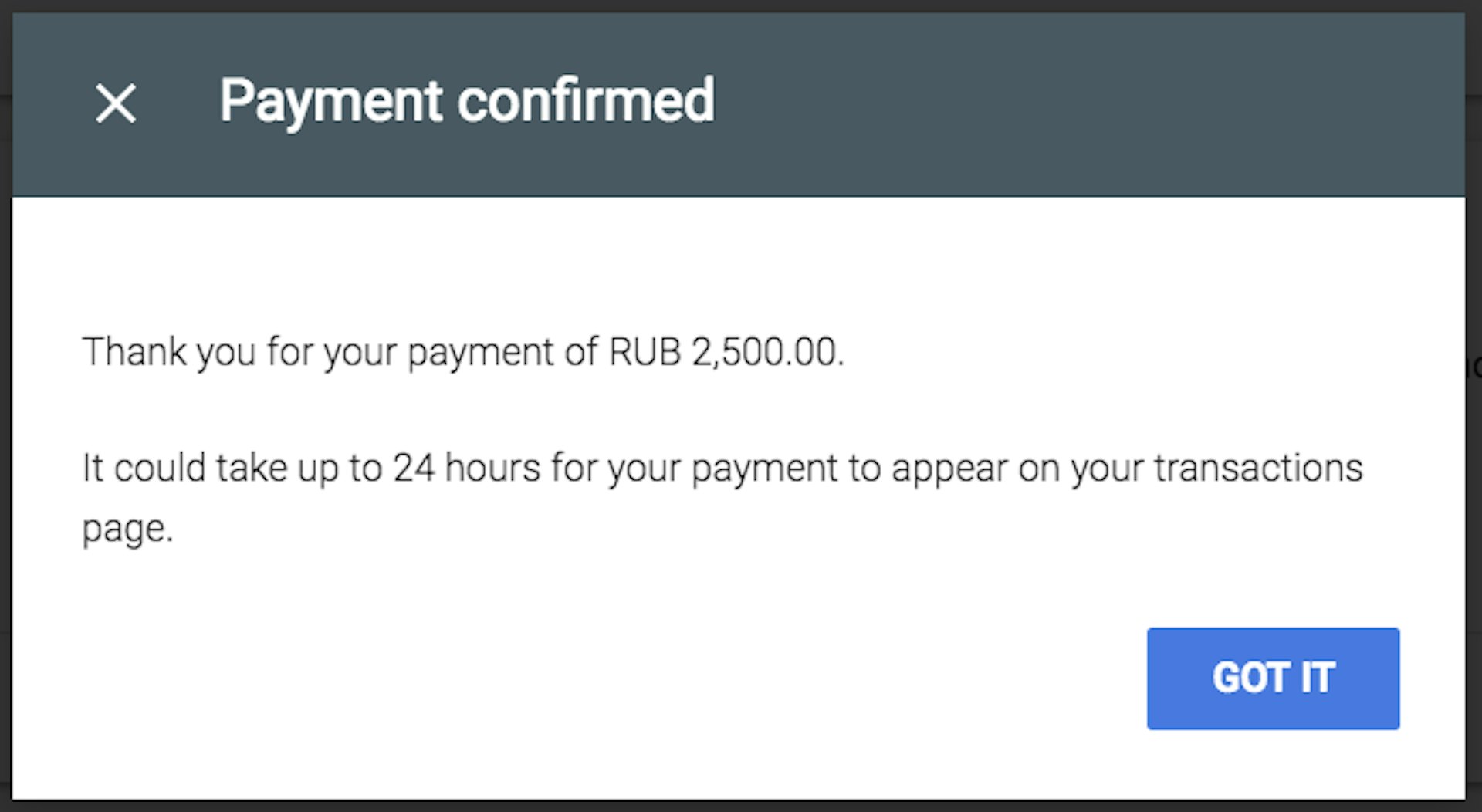
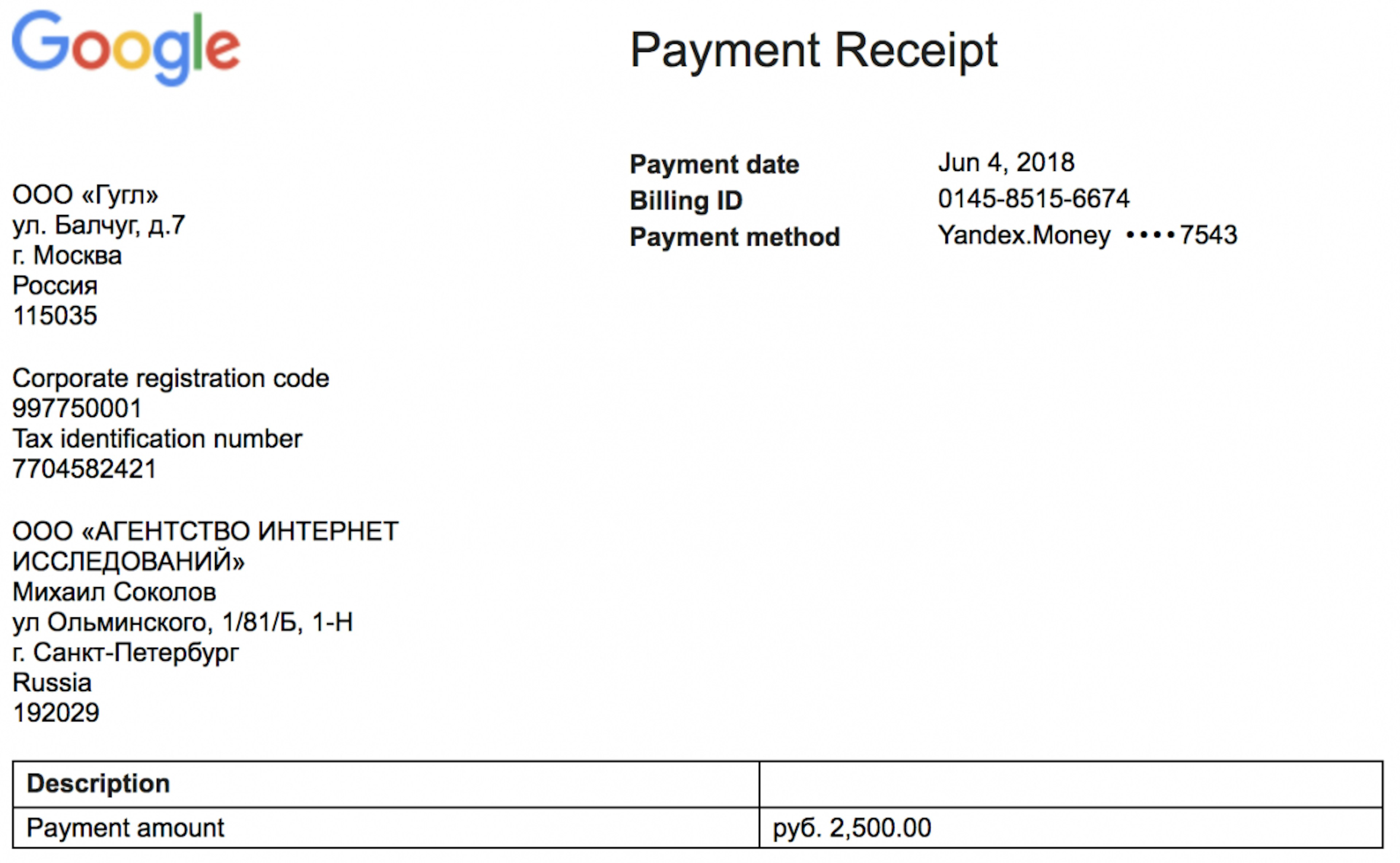
Step Six: Create the YouTube Video Our Ads Would Point To
We started by creating a simple 30-second YouTube video using Facebook memes previously posted by accounts identified as having been created by the Kremlin-linked trolls: Brown Power, Black Matters and Blacktivist. The memes were obtained from a trove of ads released by the House Intelligence Committee in May 2018 as part of its investigation into Russian efforts to sow discord online.
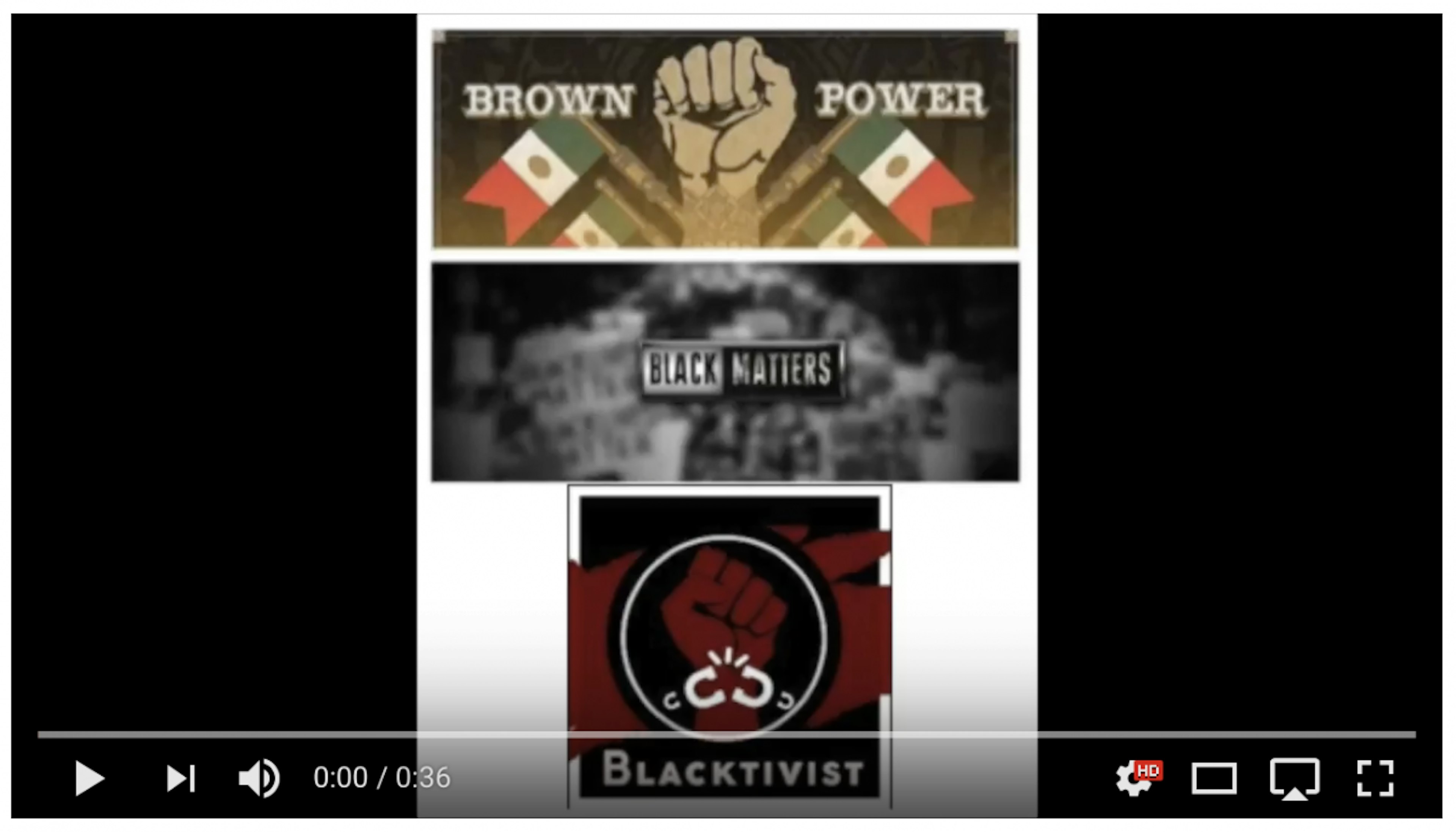
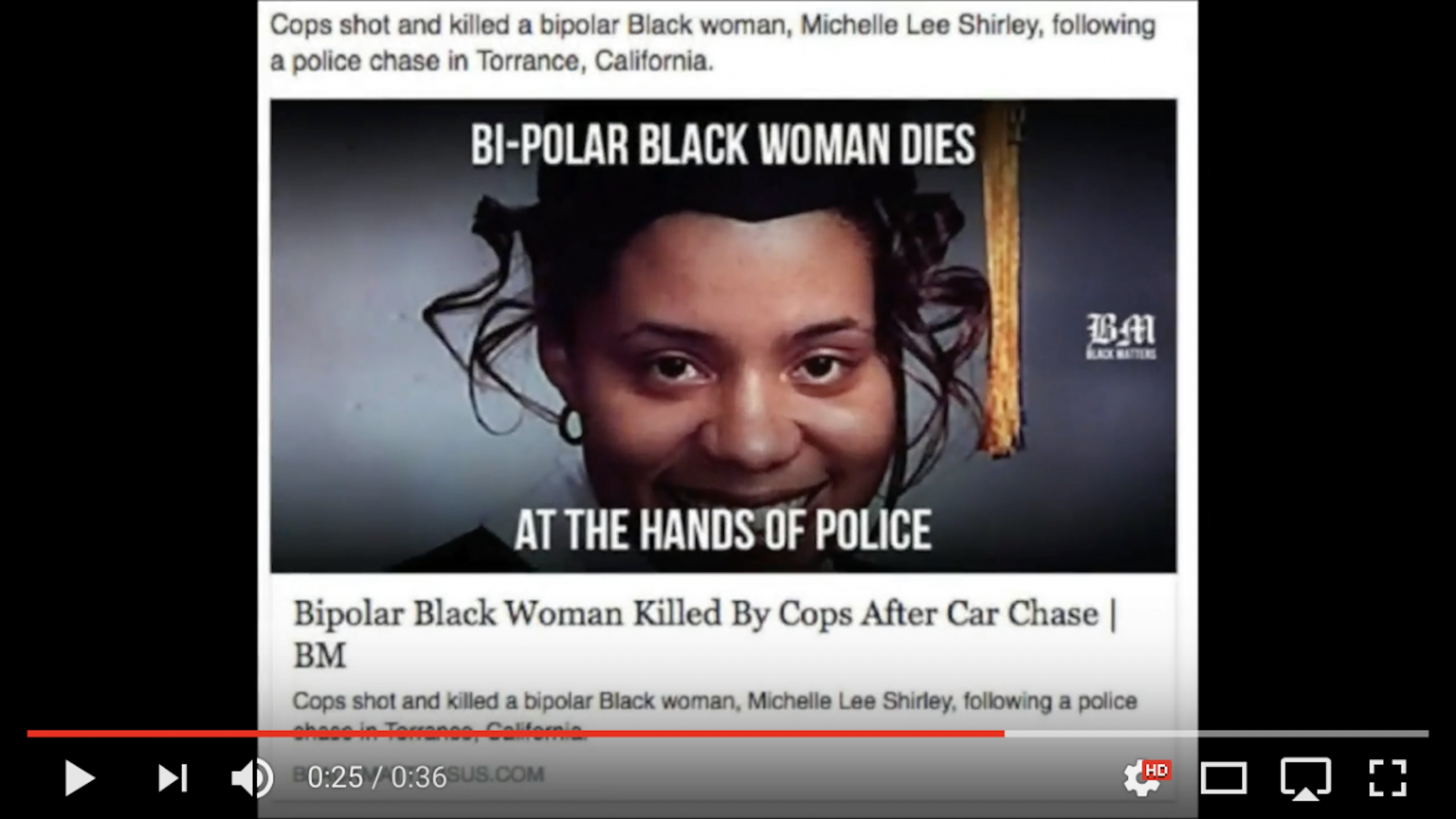
YouTube video posted with Russian Facebook memes
Step Seven: Create AdWords Campaigns
Next, we created text and display ads pointing to the YouTube video using imagery and language identical to the Russian troll websites BlackMattersUS.com and Blacktivist. Based on the text we chose for our ad campaign, Google’s AdWords feature suggested its own image of a woman crying, so we incorporated the image into our campaign along with the raised fist from various Blacktivist Facebook memes.

Native and text ads for “Black Matters” campaign. Google suggested the image used
We also chose specific demographic, keyword, and audience information for ad targeting for audiences in the United States. For instance, we chose “African-American”, “Politics” and “Scandals & Investigations” among other interest-based targeting categories that Google claims it does not allow.
Google targets ads to users based on their interests, so a user who had previously searched for marathon training plans might see an ad for running shoes while she is reading the news. Google showed ads to people it identified as interested in the topics we defined.
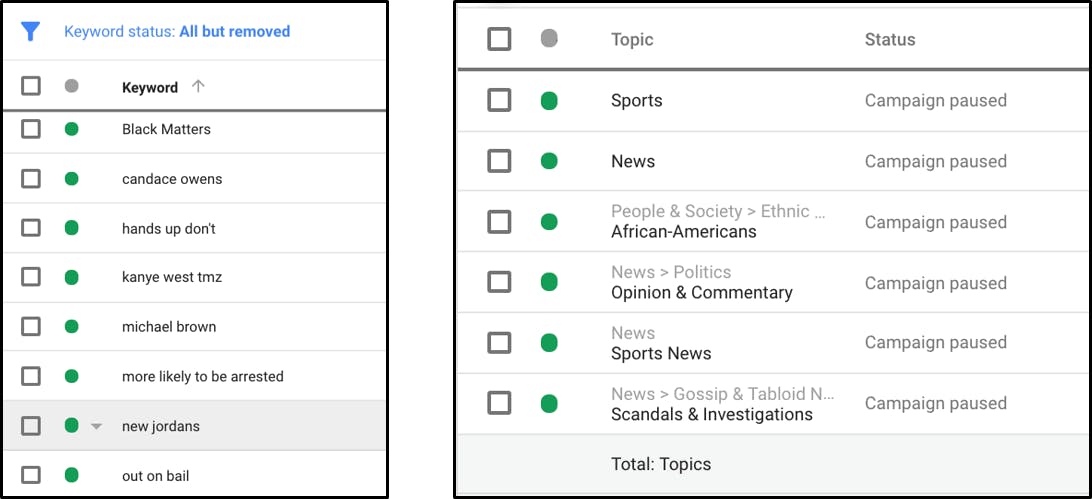
Our test ad was submitted on June 11 and quickly approved on June 13. The campaign ran for two days, generating 5,787 impressions and 56 clicks at a total cost of 398 rubles (approximately US$6.30).

According to Google, our ads appeared on the YouTube channels for several prominent media brands, including CBS This Morning, CNN, Comedy Central, Huffington Post, Essence and dozens of other popular websites and YouTube channels. Google says that ad placement is a function of the keywords selected when creating an AdWords campaign.

Selected YouTube channels where the ads ran
For our second AdWords campaign, we directed U.S. internet users to a new website widely reported to have been set up by the Russian trolls: USAReally.com. According to news reports, an offshoot of the St. Petersburg-based IRA known as RIA FAN (riafan.ru) created the site to provide information on what they say is the “growing political censorship imposed by the United States.”
We used imagery directly from the USAReally.com website for a June 14 “flashmob” the site was attempting to organize in front of the White House for President Trump’s birthday and Flag Day. We also used language directly from the website’s “About us” page for our AdWords copy.

Second Google AdWords test campaign for USAReally.com
As with our first AdWords test, we chose specific demographic, keyword, and audience information to target specific audience segments in the U.S. In this case, we chose “America first” and “patriot” among other interest-based targeting categories.

Our test ad was submitted on June 19 and approved on June 20, generating 3,774 impressions and 40 clicks at a total cost of 303 rubles (approximately US$4.79).
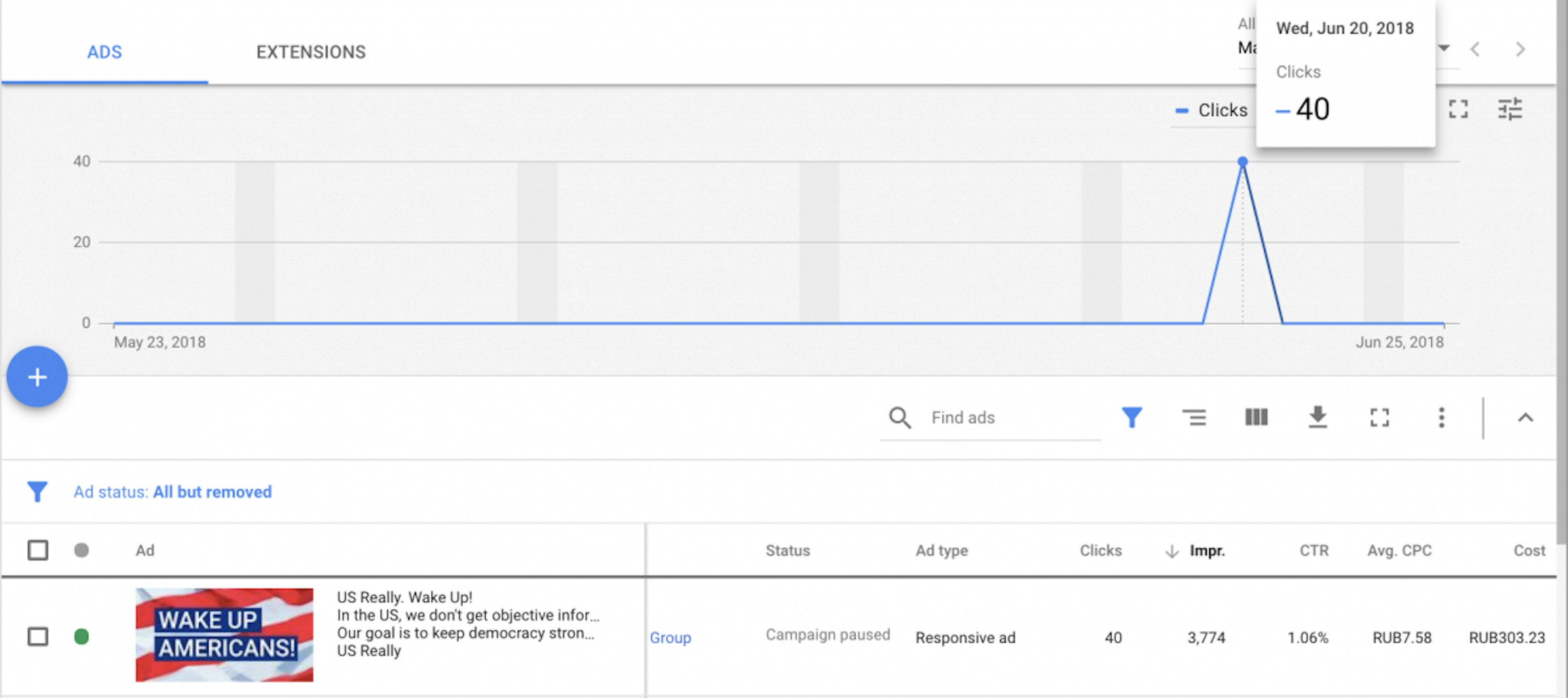
Our ads appeared on conservative sites such as AnnCoulter.com as well as YouTube channels for liberal sites such as The Young Turks and Thom Hartmann, among others. It also appeared on media web sites including The Daily Beast and Britain’s Daily Mail.

Selected websites and YouTube channels where the ads ran
For our third campaign, our ads directed users to another site created by the Russian troll farm in 2016, BlackMattersUs.com. A November 2017 article in Slate reported that the site was designed to look like a hub of racial-justice activism, but was in fact the creation of the Kremlin-funded Internet Research Agency.
According to an investigation by the independent Russian news site RBC, the site remains one of the most influential websites and social media accounts run by the IRA. And while Facebook has banned BlackMattersUs, CfA had no problem running a Google display ad campaign pointing to the website.
As with our previous campaigns, we chose images and ad copy directly from the BlackMattersUS.com web site. In fact, Google again helpfully recommended images, this time directly from the website.

Images from the original Russian troll site

Images suggested by Google AdWords
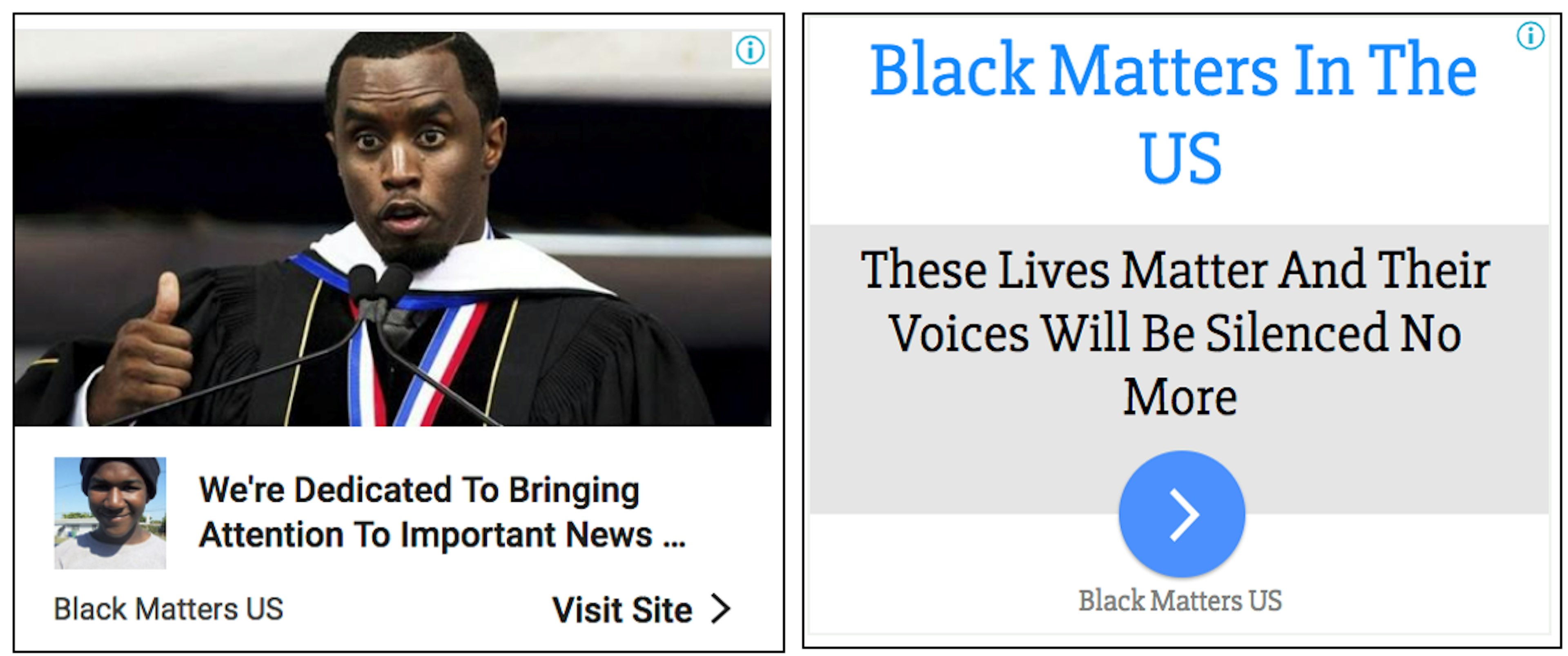
Final ads that ran online
We also chose specific keywords and demographics for our ad targeting.
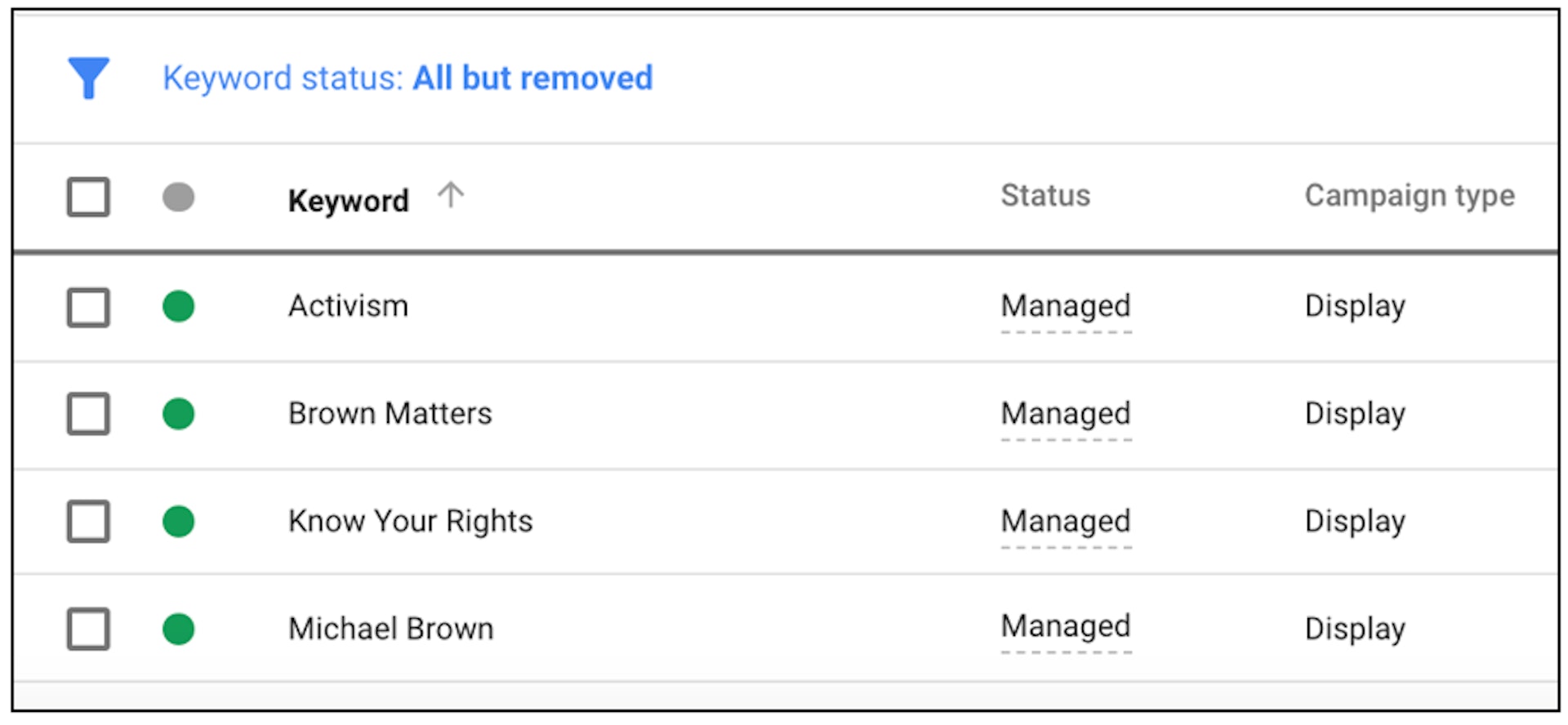
Our ad was submitted on June 28 and approved on June 30, initially generating 10,833 impressions and 110 clicks at a total cost of 879 rubles (approximately US$14). This ad ran an extra day generating an additional 78 clicks for a total of 188 clicks and a total cost of 1487.50 rubles
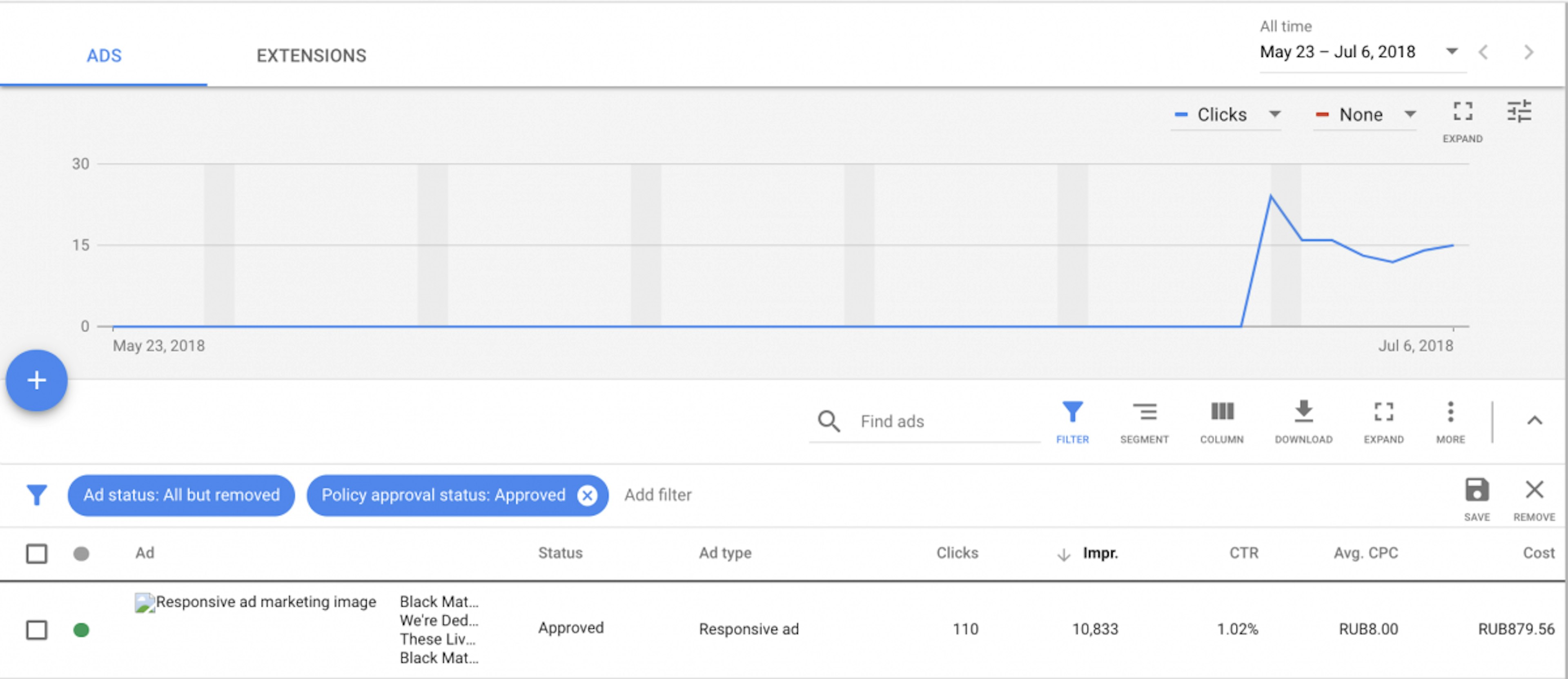
In all, our testers spent just 2188 rubles (approximately $35), generating more than 20,000 impressions and 284 clicks on precisely the kinds of ads that Google has pledged to block.
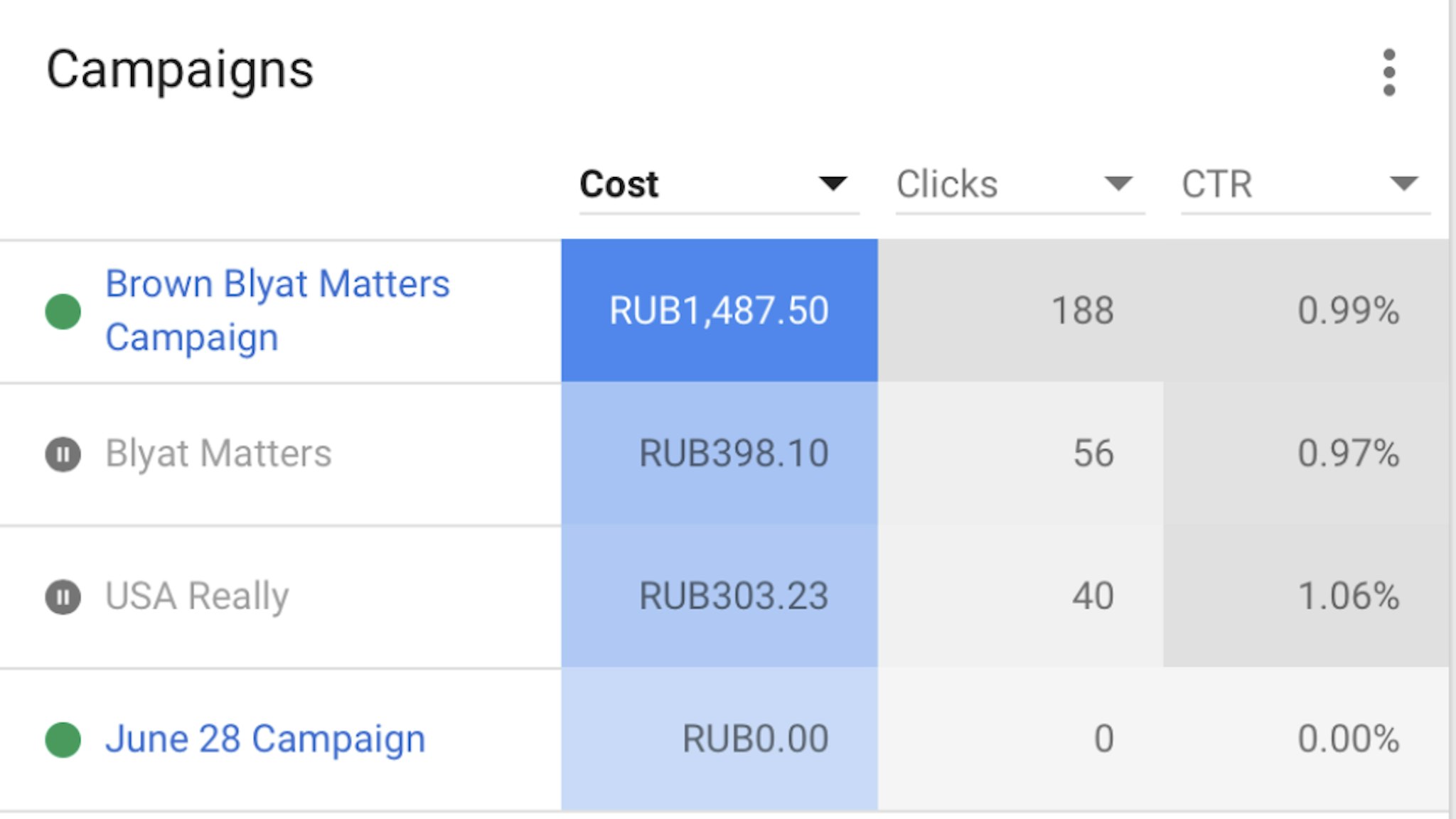
Our testers tried a final test of two political ads—one targeting Democrats and the other Republicans— on June 28. Google did not approve those ads, citing “misrepresentation” (though not apparently for violating its stated ad policies for political advertising or political ads purchased by foreign actors.)

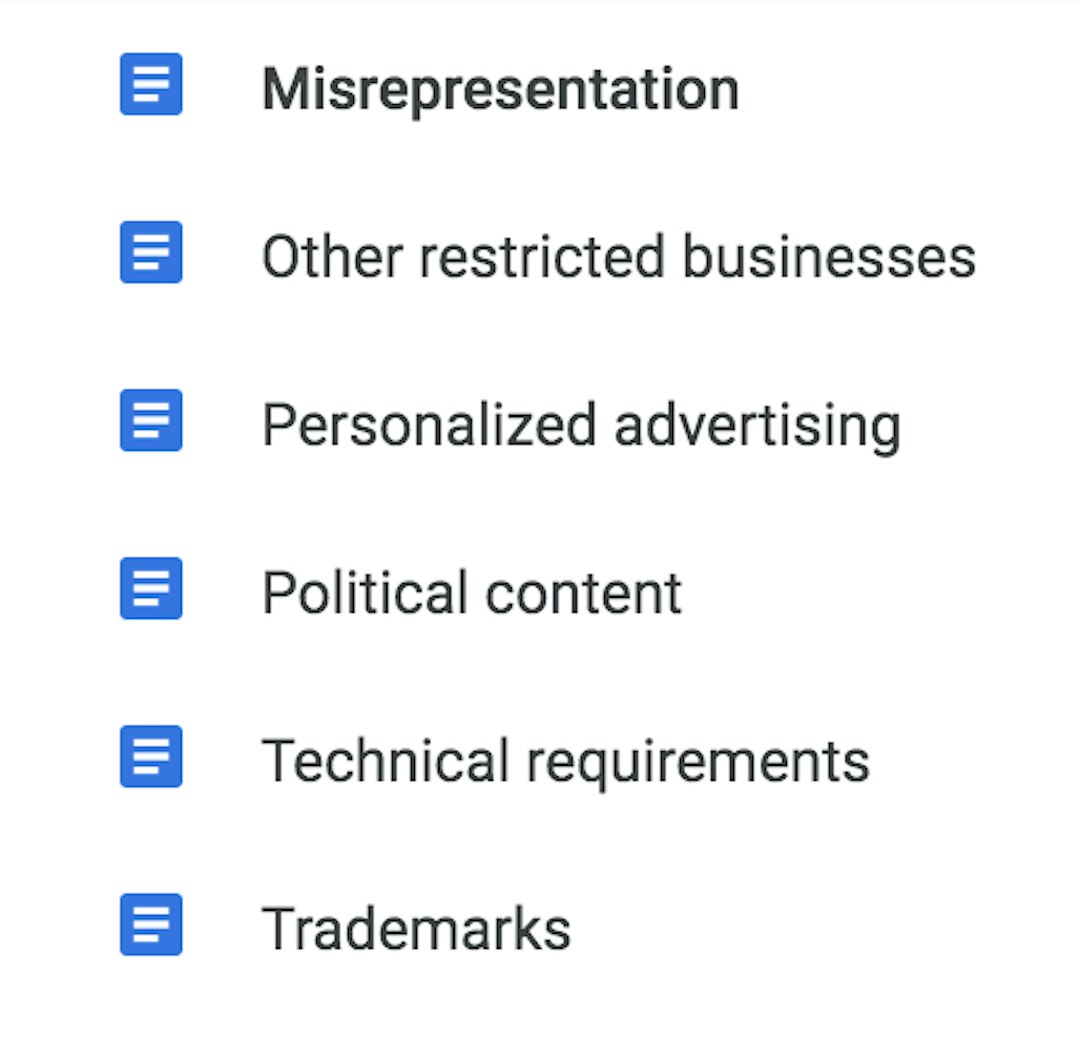
Even after the political ads were disapproved, our AdWords account remained active and in good standing with Google.
Russia charges a 17% Value Added Tax (VAT) for all AdWords campaigns, so at the end of our tests, we exhausted our balance. Google immediately encouraged us to add money to our account so we could continue advertising.

